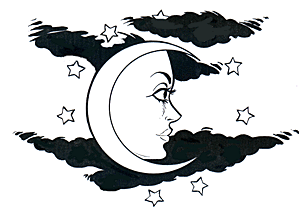Calendar, Moon Phases
(aspects of the moon are known as phases from a Greek word meaning "appearance")
Phases of the Moon
The moon's phases depend on what fraction of its sunlit hemisphere can be seen from the earth. As the moon orbits earth, it "grows in size" from new moon, to waxing crescent, first quarter (one-fourth of a completed revolution around the earth), waxing gibbous, to full moon. It then decreases in reverse order to waning gibbous, third (or last) quarter (three-quarters of a completed revolution around the earth), waning crescent, and back to the new moon (completing the full revolution around the earth).
The same side of the moon always faces the earth because the moon rotates on its axis in the same period that it revolves around the earth. The moon takes 27.3 days to complete one revolution around the earth with respect to the stars (sidereal month, 27 days, 7 hours, 43 minutes, 11.5 seconds), but the synodical month takes 29.5 days (29 days, 12 hours, 44 minutes, 3 seconds) with respect to the sun because of the earth's simultaneous motion around the sun. Sidereal rotation is anything that is measured with respect to the stars rather than with respect to the Sun or the primary of a satellite.

The "new moon", or first light after the "dark of the moon" is how people have measured time for thousands of years. The responsibility for keeping time was originally the responsibility of priests of the state religion of the time. The meeting of priests and other religious officials is known as a synod and it was such a group that determined when the new moon had arrived. The astronomical period from "new moon" to "new moon" is even today called the synodical month. The term synodical is defined as an astronomical term meaning "relating to the alignment of celestial bodies".
During Roman times, the Pontifex Maximus (high priest) would be responsible for proclaiming the beginning of a new month when he saw the new waxing crescent of the moon. The Latin word for "proclaim" or "announce" is kalare and that's why the Roman calendar always started with the Calends (Kalends) and that's where the English word for "calendar" comes from.
Examples of the various phases of the moon
Festivals are observed among many people and thankful prayers are said for the reappearance of the missing light in the sky when it starts to wax again; that is, when the first thin slice of light appears along the moon's eastern edge is seen from the earth.
Like the earth, half of the moon is always lighted by the sun's rays except during an eclipse. Usually the far side of the moon (from the earth) is in full sunlight even though it is out of earth's view.
